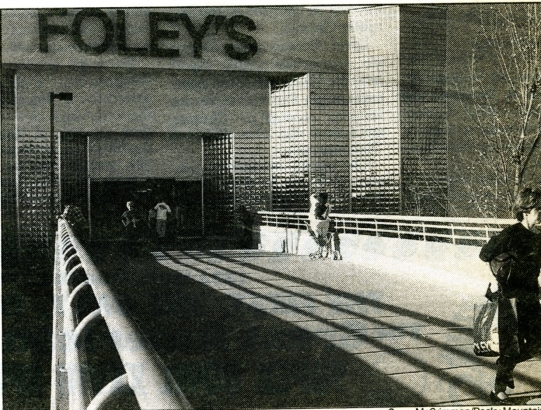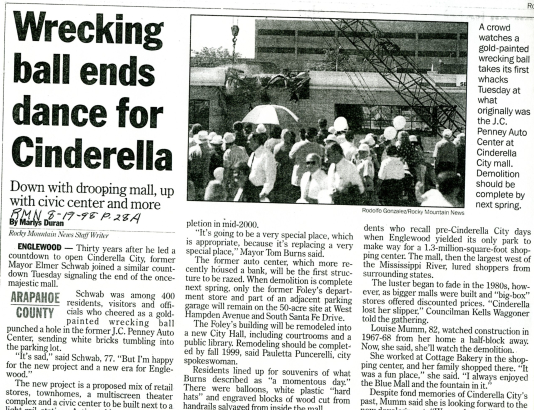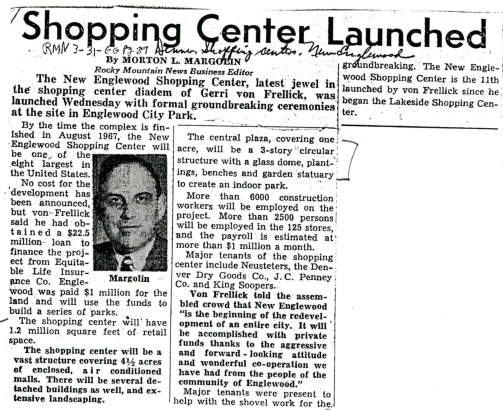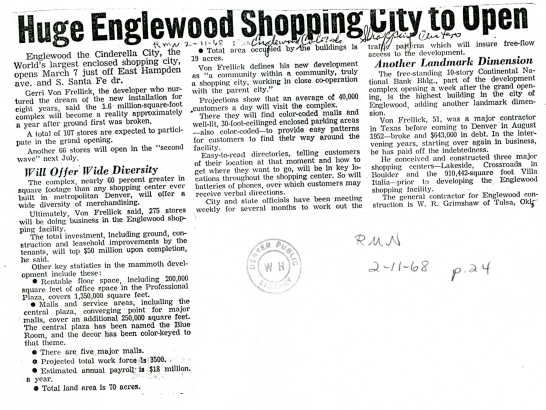On March 7, 1968, after nearly a decade of planning, Cinderella City opened its doors. To learn more about how the mall came to life, check out Cinderella City: The Rise and Fall a Memorable Mall (Part 1)
Cinderella Arrives at the Ball
Cinderella City's opening weekend, and subsequent couple of decades, were hugely successful. The excitement of opening day was enhanced by huge special sections in both Denver daily newspapers.
Oddly enough, the mall wasn't really complete when it opened its doors that day. Only 100 stores were open, but Von Frellick was insistent that his mall open on time. The fact that he would lose around $400,000 a month in rent (about $2.8 million in 2017 dollars) certainly factored into his decision to launch in March. Plans were made for a full grand opening, with all 250 stores, in June.
To help deal with expected onslaught, the Englewood Police Department brought in 30 off-duty Denver Police officers as reinforcements. Englewood Police Chief Jack Clasby described the opening as, "the largest commitment of law enforcement officers in the history of Englewood."
Chief Clasby was hardly the only one to embrace superlatives in regard to Cinderella City. The Rocky Mountain News' special section is bursting with facts exclaiming the new mall's many wonders. These ranged from the 14,000 parking spaces to the three-deck refrigerated cases at the Cinderella City King Soopers, to the four massive air conditioning units that kept the dream from overheating.
Englewood Mayor Elmer Schwab was able to contain himself enough to speak these measured words regarding his city’s new crown jewel, saying the event was, “...the greatest moment ever in Englewood's history - an Alice in Wonderland come true."
Though opening day at Cinderella City didn’t draw a million shoppers, it definitely drew thousands. Von Frellick himself presided over the opening ceremonies which included the ceremonial launch of the mall's signature water fountains. These sorts of fountains were a mainstay in malls across the country and, it's fair to say, that subsequent mall fountains were definitely inspired by the Blue Mall's massive water works.
The Golden Years
Cinderella City’s unique design, featuring six distinct shopping areas – the Blue Mall, the Rose Mall, the Sunflower Mall, the Gold Mall, the Shamrock Mall, and Cinder Alley – was a huge hit with shoppers from across the Rocky Mountain West.
That success filled the City of Englewood's coffers with a torrent of tax revenue. According to a Denver Post report from May 20, 1970, Cinderella City's impact on Englewood was nothing short of incredible. Among other things, all the fairy tale money allowed Englewood to increase its student spending from $670 per pupil to $824.87.
Cinderella City was also a boon for the man who dreamed it up. In 1978, Von Frellick sold his share in the mall to a group of New York investors for $35 million (about $130 million in 2017 dollars). By that point, Cinderella City's 235 merchants had generated more than $45 million in sales taxes for the City of Englewood.
The good times, however, were not to last. Just as in the fairy tale of the same name, Cinderella City had an appointment with the midnight hour.
The Clock Strikes Midnight
Retail shopping habits are a notoriously fickle beast. By the time the 1990s arrived, consumers weren't quite as impressed by fountains and chandeliers as they'd once been.
In Cinderella City's case, a group of new malls, including Southwest Plaza and Westminster Mall, had poached many of its customers who'd once been willing to drive great distances for the chance to shop at the West's largest shopping center. Slowly but surely, these competitors choked the life out Englewood's crown jewel.
As early as 1991, local retail analysts had written off the mall entirely. In an interview with the Denver Post date December 6, 1991, an unnamed retail expert said, "When it was built, it was the hottest thing in town -- it was one of the biggest malls in the country and, in our little cow town, was a unique attraction. But as suburban malls proliferated, it was squeezed from all sides and its immediate area isn't that affluent."
In 1992, the mall only generated $1.85 million in tax revenues and that was down from $3 million in 1981.
Besides changing consumer habits, Cinderella City was also dealing with a ghost from its pre-mall, pre-Englewood City Hall, days. Cinderella City, it turns out, was built on what had once been the Englewood town dump.
After a few decades of supporting the weight of one of the world's biggest shopping malls, the ground where the dump had been was shifting, creating serious structural problems for the mall. Towards the very end of Cinderella City's run, Cinder Alley was deemed too unsafe to host shoppers and was shuttered entirely.
As the 1990s drew to a close, Cinderella City was in dire shape. Most of its retail tenants had long since fled. The few that remained, around three when they finally shut down for good, were in desperate need of paying customers.
Not only were there not many places to actually shop, but by the late 1990s, Cinderella City was a pretty spooky place to visit. All that empty space was hardly the stuff of a pleasant afternoon of shopping. Mall security guards complained that gang members used the dead space to commit, "felonious acts."
After a few futile attempts at reviving Cinderella City, the mall's owners and the City of Englewood threw in the towel. On August 18, 1998, the process of demolition began and Cinderella City's night at the ball, all thirty years of it, was done. Once again, Elmer Schwab oversaw the proceedings.
By the end of the year, demolition crews were hard at work leveling the once-glamorous complex.
Aftermath
Despite Cinderella City's shabby end, the property on which it stood remained quite valuable. In 2000, the space was re-developed to hold the new Englewood City Hall, a Wal-Mart and other, more modern, retail options.
Will these facilities meet the same fate as Cinderella City? If history is any guide, a new set of stores will be standing on that same plot in just a few decades.
If you enjoy Denver history, see more articles like this on our Facebook page!


![A long hallway with a sign reading "Blue Mall" at Cinderella City shopping center in Englewood, Colorado, has small stores on either side. "Harry's Hutel [sic]" has a poster of W. C. Fields, balloons, and other merchandise on display; "Musicland" has scaffolding in front, and another shops has a canopy. "Pier 1 Imports" is at the end of the mall. A dropped ceiling with flourescent lighting in overhead.](/sites/history/files/styles/blog_image/public/cdm_9289_0.jpg?itok=aANnFqsY)




Comments
The sad thing is that while
The sad thing is that while retail facilities are basically viewed by developers as "equipment" that becomes obsolete, malls like Cinderella City were like town centers for the people who used them and they tended to develop emotional attachments to them. There are a number of "dead malls of America" sites on the internet and they're all full of comments by viewers about their memories of shopping there, or taking dates out to movies, or just hanging around. I don't think that it's feasible to repurpose these places (especially if it's falling down like CC was) but it's a bit dispiriting to know that places you grow up around and become attached to will almost certainly be wiped away during your lifetime.
Great point, Jude. Most
Great point, Jude. Most people don't seem to have the same kind of emotional attachment to outdoor shopping centers that they had to indoor malls.
Good point Jude -- shopping
Good point Jude -- shopping malls were like town centers where people would often go just to "hang around." No place seems to be filling this void. Libraries have also long been community centers to some degree, but not so much for the socializing extent that malls were. Most centers/venues now are in/buy/out, and outdoor plazas often aren't the most pleasant places due to weather and noise.
You're right on the money,
You're right on the money, Joe. Our shared public spaces are a lot smaller, and there are fewer of them, than they once were.
There were so many malls in
There were so many malls in those days and now most of them have disappeared - U-Hills, Northglenn, Cinderella City, Villa Italia, Buckingham, Crossroads. Yikes!
Hi Suzanne - Thanks for
Hi Suzanne - Thanks for commenting. It is hard to believe that the malls that were permanent fixtures of our childhood memories could turn to trash heaps in such a short time. Such is the ever changing nature of retail sales!
I spent my entire 54 years of
I spent my entire 54 years of my life in the Denver area and just about all of the earlier malls are gone. The newer malls don't have the same kind of charm as the older ones. I practically grew up in Cinderella City and Villa Italia malls and also knew Lakeside Mall and the smaller Westland Mall and did manage to visit Northglen and Southglen malls. We visited Southwest Plaza Mall when it opened and has since gone through a dramatic redevelopment and I have spent time at Colorado Mills but it's just not the same.
And Bear Valley, North Valley
And Bear Valley, North Valley, Westminster, and Westland.
I miss the malls. Villa
I miss the malls. Villa Italia, Westminster and the best one was Cinderella City. RIP
This is a really great
This is a really great history and really hits home for me, even though I grew up in the era of Cinderella City’s decline. I was wondering if anyone at the library I ran what happened to the double decker carousel?
Add new comment